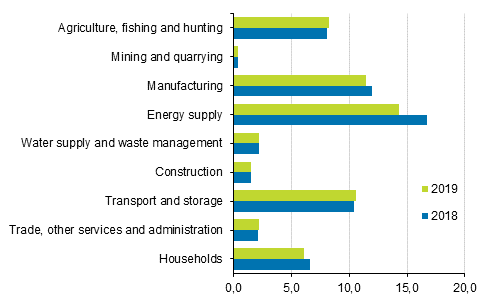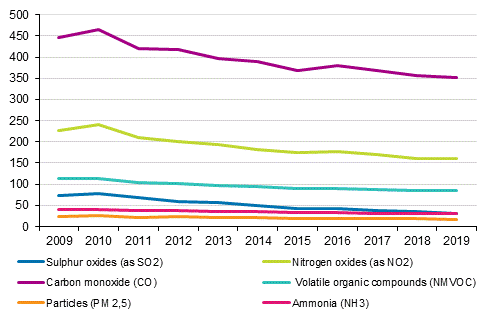Published: 30 September 2021
Greenhouse gas emissions of Finns fell in 2019 – emissions of impurities remained on level with the previous year
Greenhouse gas emissions produced by Finns fell in 2019. At the same time, emissions of impurities remained mainly on level with the previous year. Greenhouse gas emissions in Finland and abroad amounted to 57 million tonnes, five per cent less than in the previous year. The main reason behind the fall was the nearly 15 per cent reduction in emissions from energy production, as the consumption of coal and peat diminished from the year before. The most significant reduction in emissions of air impurities was seen in sulphur dioxide emissions, which decreased by nearly ten per cent.
Greenhouse gas emissions by industry in 2018 and 2019, million tonnes CO2 equivalent

The fall in greenhouse gas emissions was mostly due to reduced emissions from energy supply. Greenhouse gas emissions from energy supply decreased by 15 per cent from 2018 as production of condensate electricity went down. Energy supply’s annual emission volumes vary considerably especially on account of electricity imports and production of fossil condensate energy, whose volumes are, in turn, dependent on the availability of hydro power on the Nordic electricity market. Emissions from manufacturing diminished by four per cent. The fall in emissions from manufacturing was particularly caused by the 10 per cent drop in emissions from the metal industry as steel production declined. Emissions from trade went down by five per cent from the previous year.
Emissions from households' heating and transport decreased. Emissions from heating of buildings fell by seven per cent because the weather was warmer than in the previous year and the need for energy was thus lower. By contrast, emissions from households’ transport decreased by eight per cent as a result of reduced consumption of petrol and increased share of alternative motive power.
Carbon dioxide emissions from biomass, which are not counted as greenhouse gas emissions, grew by nearly two per cent and amounted to 43 million tonnes. The growth was particularly due to increased use of biofuels in transport and increased use of wood fuels in manufacturing and energy production.
Emissions of impurities in 2009 to 2019, thousand tonnes

Nitrogen oxides are expressed as converted into nitrogen dioxide (NO2)
Sulphur oxides are expressed as converted into sulphur dioxide (SO2)
At the same time, emissions into air not included in greenhouse gases remained mainly on level with the previous year. The most significant change in emissions occurred in sulphur dioxide emissions, which decreased by ten per cent in a year. This development was mainly affected by the 15 per cent reduction in sulphur dioxide emissions in energy supply as consumption of hard coal decreased. Emissions of carbon monoxide and non-methane volatile organic compounds (NMVOC) also decreased by 1.5 per cent from the previous year. Carbon monoxide emissions are mostly generated from households' burning of wood and transport. Large amounts of NMVOC emissions are generated in agriculture and households’ burning of wood. Emissions of nitrogen oxides, particulate matter and ammonia remained on level with the previous year.
Emissions into air by industry groups 2019, tonnes
| Greenhouse gases (CO2-foss, CH4, N2O, HFC, PFC, SF6) CO2-eq. | Carbon dioxide emissions from biomass (CO2-bio) | Particles, < 2,5 m (PM 2,5) | Carbon monoxide (CO) | Nitrogen oxides (as NO2) 1) | Sulphur oxides (as SO2) 2) | |
| Agriculture, forestry and fishing | 8 244 314 | 930 734 | 1 010 | 14 374 | 6 531 | 948 |
| Mining and quarrying | 431 162 | 450 | 771 | 1 664 | 1 564 | 53 |
| Forest industry | 2 799 541 | 21 134 877 | 1 292 | 24 408 | 18 565 | 3 392 |
| Oil refining and manufacture of chemicals | 3 870 581 | 160 751 | 253 | 1 441 | 3 152 | 5 489 |
| Manufacture of basic metals and fabricated metal products | 3 197 849 | 5 441 | 301 | 1 100 | 3 066 | 3 559 |
| Other industries | 1 637 903 | 149 604 | 480 | 3 648 | 2 882 | 1 132 |
| Energy management | 14 277 916 | 12 878 001 | 278 | 14 811 | 24 808 | 11 419 |
| Water supply and waste management | 2 242 387 | 308 346 | 2 | 129 | 649 | 76 |
| Construction | 1 542 892 | 104 884 | 453 | 6 221 | 6 607 | 23 |
| Trade | 475 750 | 56 790 | 39 | 170 | 249 | 32 |
| Land transport | 3 902 121 | 579 458 | 853 | 2 994 | 14 833 | 49 |
| Water transport | 2 801 366 | 5 389 | 613 | 5 490 | 42 186 | 1 923 |
| Air transport | 3 698 431 | 23 169 | 193 | 5 166 | 15 566 | 941 |
| Other service activities and administration | 1 987 580 | 429 742 | 693 | 30 503 | 5 947 | 557 |
| Households | 6 143 039 | 6 146 597 | 10 064 | 240 698 | 14 116 | 1 552 |
| TOTAL | 57 252 832 | 42 914 233 | 17 295 | 352 817 | 160 721 | 31 145 |
2) Sulphur oxides are expressed as converted into sulphur dioxide (SO2)
The statistics on emissions into air by industry are calculated according to the EU Regulation on environmental accounts. The industrial classification and division used in the statistics differ from the sector division used in the reporting of the greenhouse gas emissions to the UNFCCC. The statistics do not take into consideration the amount of carbon dioxide absorbed by forest or other vegetation either.
Differing from the greenhouse gas inventory and greenhouse gas reporting, the statistics on emissions into air by industry also contain emissions from land, water and air transport abroad caused by Finnish economic units. In turn, emissions by foreign citizens from transport on Finnish territory are subtracted from the emissions into air by industry. Due to definitional differences, the total volume of greenhouse gas emissions by industry is higher than in the Greenhouse Gas Inventory reported to the UNFCCC.
Source: Emissions into air by industry 2019, Statistics Finland
Inquiries: Juuso Peltola 029 551 2330, Kai Skoglund 029 551 2675, ymparistotilinpito@stat.fi
Head of Department in charge: Katri Kaaja
Publication in pdf-format (185.8 kB)
- Tables
-
Tables in databases
Pick the data you need into tables, view the data as graphs, or download the data for your use.
Updated 30.9.2021
Official Statistics of Finland (OSF):
Emissions into air by industry [e-publication].
ISSN=2323-7600. 2019. Helsinki: Statistics Finland [referred: 28.12.2025].
Access method: http://stat.fi/til/tilma/2019/tilma_2019_2021-09-30_tie_001_en.html

